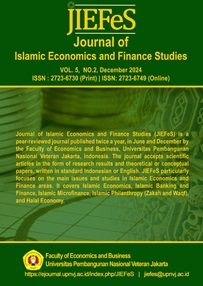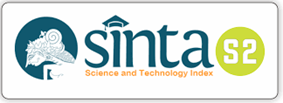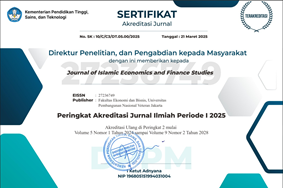Determinants of Banten Young People's Intention to Pay Waqf Through Digital Platforms
DOI:
https://doi.org/10.47700/jiefes.v5i2.9295Keywords:
Theory of Planned Behaviour, Cash Waqf, Generation X, Generation YAbstract
The potential for cash waqf in Banten reaches IDR 55 billion per month or IDR 667.2 billion per year, but the realization is still far from expectations. One of the factors is related to the low literacy of the community, especially generation Y and Z about waqf. In a survey conducted by the Indonesian Waqf Board, the waqf literacy index score of Banten province in 2020 was 45.47 and the Waqf Basic Understanding Index Score was 50.88, this figure is in the low category. This study aims to determine the factors that influence the intention of Banten young people to donate through digital platforms, by adopting the concept of the Theory of Planned Behavior (TPB) which consists of subjective norms, perceived behavioral control, behavioral attitudes plus reliability and their influence on the intention to donate. This study uses an associative quantitative approach, the analysis was carried out using Structural Equation Modeling (SEM) with the SmartPLS application tool to test seven hypotheses of the relationship between variables in the model. Respondents, as many as 124 people were selected through a purposive sampling technique to get Muslim respondents interested in waqf through digital platforms. The results showed that subjective norms do not have a positive effect on behavioral intentions, perceived behavioral control has a positive and significant effect on behavior intention, religiosity has a significant positive effect on behavioral intention, attitude has a significant positive effect on behavioral intention. This study implies the need to improve their understanding through more intensive education and counseling, and the use of digital platforms that can facilitate access, transparency, and trust, developing and promoting digital platforms that are easily accessible, user-friendly, and secure. a more personalized approach in waqf campaigns, which emphasizes the religious aspects and direct benefits of waqf itself, to encourage waqf intentions.
Potensi wakaf uang tunai di Banten mencapai Rp55 miliar per bulan atau Rp. 667,2 miliar per tahun, tetapi pada realisasinya masih jauh dari harapan. Salah satu faktornya terkait literasi masyarakat khususnya generasi Y dan Z tentang wakaf masih rendah, Dalam survey yang dilaksanakan Badan Wakaf Indonesia skor indeks literasi wakaf provinsi Banten pada Tahun 2020 diangka 45,47 dan Skor Indeks Pemahaman Dasar Wakaf mendapatkan angka 50.88, angka tersebut masuk dalam kategori rendah. Penelitian ini bertujuan untuk mengetahui faktor-faktor yang mempengaruhi niat anak muda Banten untuk berwakaf melalui platform digital, dengan mengadopsi konsep Theory of Planned Behavior (TPB) yang terdiri dari norma subyektif, kontrol perilaku yang dipersepsikan, sikap perilaku ditambah dengan keandalan dan pengaruhnya terhadap niat berdonasi. Penelitian ini menggunakan pendekatan kuantitatif asosiatif, analisis dilakukan dengan menggunakan Structural Equation Modeling (SEM) dengan alat bantu aplikasi SmartPLS untuk menguji tujuh hipotesis hubungan antar variabel dalam model. Responden sebanyak 124 orang dipilih melalui teknik purposive sampling untuk mendapatkan responden muslim yang tertarik berwakaf melalui platform digital. Hasil penelitian menunjukkan bahwa norma subjektif tidak berpengaruh terhadap niat berperilaku, kontrol perilaku yang dipersepsikan berpengaruh terhadap niat berperilaku, religiusitas berpengaruh terhadap sikap niat berperilaku, sikap berpengaruh positif signifikan terhadap niat perilaku. Penelitian ini mengimplikasikan perlu meningkatkan pemahaman mereka melalui pendidikan dan penyuluhan yang lebih intensif, dan penggunakan platform digitalyang bisa mempermudah akses, transparansi, dan kepercayaan, mengembangkan dan mempromosikan platform-platform digital yang mudah diakses, user-friendly, dan aman. pendekatan yang lebih personal dalam kampanye wakaf, yang mengedepankan aspek religiusitas dan manfaat langsung dari wakaf itu sendiri, untuk mendorong niat berwakaf.
References
Ajzen, I., & Fishbein, M. (2000). Attitudes and the Attitude-Behavior Relation: Reasoned and Automatic Processes. European Review of Social Psychology, 11(1), 1–33. https://doi.org/10.1080/14792779943000116
Al-Humam, I. (n.d.). Fathul Qodir.
Alifiandy, M. M., & Sukmana, R. (2020). the Influence of Planned Behaviour Theory and Knowledge Towards the Waqif Intention in Contributing Waqf. Jurnal Ekonomi Dan Bisnis Islam (Journal of Islamic Economics and Business), 6(2), 260. https://doi.org/10.20473/jebis.v6i2.22624
Amirul Faiz Osman. (2014). An analysis of cash waqf participation among young. 9th International Academic Conference, April, 572–584.
Arif Novriansyah, M. (2018). Pengaruh Pengangguran dan Kemiskinan Terhadap Pertumbuhan Ekonomi di Provinsi Gorontalo. Gorontalo Development Review, 1(1), 59. https://doi.org/10.32662/golder.v1i1.115
BWI. (2020). Laporan Indeks Literasi Wakaf Nasional 2020. 1–13. http://jurnal.untad.ac.id/jurnal/index.php/kovalen/article/view/6719
Devi, A., & Rusydiana, A. (2016). Islamic Group Lending Model (Glm) and Financial Inclusion. International Journal of Islamic Business Ethics, 1(1), 80. https://doi.org/10.30659/ijibe.1.1.80-94
Fitri, R., & Wilantoro, H. P. (2018). Analisis Prioritas Solusi Permasalahan Pengelolaan Wakaf Produktif (Studi Kasus Kabupaten Banjarnegara). Al-Muzara’ah, 6(1), 41–59. https://doi.org/10.29244/jam.6.1.41-59
Grieshammer, N. (2019). ENGAGING MILLENNIAL PHILANTHROPY IN ART MUSEUMS (Issue August).
Hasyim, F., & Nurohman, Y. A. (2021). Adopsi Teori Perilaku Berencana dalam Menganalisis Niat Melakukan Wakaf Tunai. Among Makarti, 14(1), 78–92. https://doi.org/10.52353/ama.v14i1.201
Hermawan, S., & Hariyanto, W. (2022). Buku Ajar Metode Penelitian Bisnis (Kuantitatif Dan Kualitatif ). In Buku Ajar Metode Penelitian Bisnis (Kuantitatif Dan Kualitatif ). https://doi.org/10.21070/2022/978-623-464-047-2
Huda, N., Rini, N., Mardoni, Y., & Putra, P. (2012). The Analysis of Attitudes, Subjective Norms , and Behavioral Control on Muzakki ’ s Intention to Pay Zakah. International Journal of Business and Social Science, 3(22), 271–279.
Hussain, A., Mkpojiogu, E. O. C., & Yusof, M. M. (2016). Perceived usefulness, perceived ease of use, and perceived enjoyment as drivers for the user acceptance of interactive mobile maps. AIP Conference Proceedings, 1761. https://doi.org/10.1063/1.4960891
Ibnu Manzdur. (n.d.). Kitab Lisanul Arab.
Iman, Nurul, H. N. (2022). Faktor-Faktor yang Mempengaruhi Masyarakat Berwakaf Uang di Dompet Dhuafa. Awqaf, 15(2), 78–98.
Juliana, Asnawi, A., & Robinson Sihombing, P. (2021). The Antecedent of Intention to Visit Halal Tourism Areas Using the Theory of Planned Behavior: The Moderating Effect of Religiosity. Journal of Tourism Management Research, 8(2), 127–135. https://doi.org/10.18488/journal.31.2021.82.127.135
Kertamukti, R. (2016). Instagram Religious Moderation Dialogue Space For Generation Z. 0, 1–23.
Mary E. Albritton. (n.d.). Millenial Alumni Giving : Motivations For Donating To Their Alma mater.
Medias, F. (2017). Bank Wakaf: Solusi Pemberdayaan Sosial Ekonomi Indonesia. Indonesian Journal of Islamic Literature and Muslim Society, 2(1), 61–84. https://doi.org/10.22515/islimus.v2i1.749
Musahidah, U., & Sobari, N. (2021). Determinants of the Intentions of Indonesian Muslim Millennials in Cash Waqf Using E-Payment. Jurnal Ekonomi Dan Perbankan Syariah, 9(2), 65–91. https://doi.org/10.46899/jeps.v9i2.284
Muslich, A. (2017). Peluang Dan Tantangan Dalam Pengelolaan Wakaf. Muaddib : Studi Kependidikan Dan Keislaman, 6(2), 200. https://doi.org/10.24269/muaddib.v6n2.2016.200-218
Najmudin, N., & Syihabudin, S. (2022). Subjective Norms and Behavioral Control; Its Effectiveness On Interest in Sharia Insurance. Jurnal Ilmiah Ekonomi Islam, 8(1), 39. https://doi.org/10.29040/jiei.v8i1.4089
Nizar, M. A. (2016). Pengembangan wakaf produktif dan peranan sektor keuangan di Indonesia. Pusat Kebijakan Sektor Keuangan, i, 1–15.
Nugraha, A. H. (2016). Intensi Dan Perilaku Penggunaan Menu Berbagi-Ziswaf Pada Aplikasi Bank Syariah Indonesia (Bsi) Mobile.
Nugroho, A., Najib, M., & Simanjuntak, M. (2018). Factors Affecting Consumer Interest In Electronic Money Usage With Theory Of Planned Behavior (TPB). Journal of Consumer Sciences, 3(1), 15. https://doi.org/10.29244/jcs.3.1.15-27
Osman, I., Ma’in, M., Muda, R., Husni, N. S. A., & Alwi, S. F. S. (2019). Determinants of Behavioural Intention Towards Green. International Journal of Islamic Business, 4(1), 16–38.
Pardiansyah, E., & Najib, M. A. (2023). Determinants of Banten Millennial Generation’s Intentions for Halal Tourism After the Covid-19 Pandemic. Indonesian Journal of Islamic Economics and Business, 8(2), 220–240. https://doi.org/10.30631/ijoieb.v8i2.1880
Purwanto, A. (2023). Pelatihan Kewirausahaan Bagi UMKM Kecamatan Pammana Kabupaten Wajo Pada Program Kampung Zakat Baznas. Jurnal.Lamaddukelleng.Ac.Id, 1(1), 1–9. https://jurnal.lamaddukelleng.ac.id/index.php/compile/article/view/66%0Ahttps://jurnal.lamaddukelleng.ac.id/index.php/compile/article/download/66/57
Puspadjuita, E. A. R. (2017). Factors that Influence the Rate of Unemployment in Indonesia. International Journal of Economics and Finance, 10(1), 140. https://doi.org/10.5539/ijef.v10n1p140
Qaḥf, M. (2000). Al-Waqf al-Islāmī Taṭawwuruhū, Idāratuhū, Tanmiyyatuhū. In Dār al-Fikr (pp. 1–326).
Rahmasari, D., Firdaus, F. F., Rahmawati, L., Nadia, N. El, & Hadi, N. (2020). Implementasi Wakaf Tunai Dalam Perekonomian Dan Pengembangan Infrastruktur. Jurnal Syarikah : Jurnal Ekonomi Islam, 6(2), 137. https://doi.org/10.30997/jsei.v6i2.2708
Riptiono, S. (2019). Does Islamic Religiosity Influence Female Muslim Fashion Trend Purchase Intention? An Extended of Theory of Planned Behavior. Iqtishadia, 12(1), 12. https://doi.org/10.21043/iqtishadia.v12i1.4384
Rusydiana, A. S. & A. D. (2017). Analisis Pengelolaan Dana Wakaf Uang Di Indonesia: Pendekatan Metode Analytic Network Process (Anp), Jurnal: al-Awqaf, Vol. 10 No. 2, 2017. Al-Awqaf, 10(2).
Saifullah, E. (2016). Pengantar Manajemen (Vol. 14, Issue 5).
Setyawati, H. A. (2017). Pengaruh Pengetahuan Produk Dan Religiositas. 39–46.
Sobari, N., Kurniati, A., & Usman, H. (2022). The influence of Islamic attributes and religious commitments toward halal wellness services customer satisfaction and loyalty. Journal of Islamic Marketing, 13(1), 177–197. https://doi.org/10.1108/JIMA-11-2018-0221
Sudarsono, H., & Nugrohowati, R. N. I. (2020). Determinants of the Intention to Consume Halal Food, Cosmetics and Pharmaceutical Products. Journal of Asian Finance, Economics and Business, 7(10), 831–841. https://doi.org/10.13106/jafeb.2020.vol7.no10.831
Syarbini. (337 C.E.). Mughnil Muhtaj, Beirut : Darul Faikri (p. 4).
Usman, H. (2015). the Role of Religious Norms on Selecting the Islamic Bank. Al-Iqtishad: Journal of Islamic Economics, 7(1), 31–44. https://doi.org/10.15408/ijies.v7i1.1356
Downloads
Published
Issue
Section
License
Copyright (c) 2024 Mohamad Ainun Najib, Yayat Sujatna

This work is licensed under a Creative Commons Attribution 4.0 International License.
Authors who publish with this journal agree to the following terms:
- Authors retain copyright and grant the journal right of first publication with the work simultaneously licensed under a Creative Commons Attribution 4.0 International License that allows others to share the work with an acknowledgment of the work's authorship and initial publication in this journal.
- Authors can enter into separate, additional contractual arrangements for the non-exclusive distribution of the journal's published version of the work (e.g., post it to an institutional repository or publish it in a book), with an acknowledgment of its initial publication in this journal.
- Authors are permitted and encouraged to post their work online (e.g., in institutional repositories or on their website) before and during the submission process, as it can lead to productive exchanges, as well as earlier and greater citation of published work.

This work is licensed under a Creative Commons Attribution 4.0 International License.











